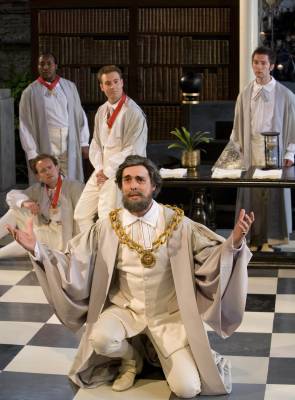|
<< -- 7 -- Roderic Dunnett WIT AND ORIGINALITY

As Garsington's spirited and diverting production showed, The Philosophers' Stone (thanks to Schikaneder's fertile imagination) has many story aspects -- including two pairs of lovers, one serious (Nadir, Nadine) and one comic (Lubano, Lubanara), a magic bird, a cooing or clucking aria and one passage of extraordinary patter that anticipates Papageno and Papagena's duet, all of which feel as stylish and funny as The Magic Flute itself.
So this brilliant forerunner of The Flute is no mere clumsy mélange, concocted by a few jobbing performers in dire need of a living wage (although they were in a sense both of those): it has pace; structure; invention; loads of life; and a clutch of cheery (yet integral) vignettes almost as memorable as The Flute itself.

Damian Thantrey as the high priest Sadik in the Garsington Opera 2006 production of 'The Philosophers' Stone'. Photo © 2006 Johan Persson
|
True, the weighty figures of Sadik (sung by Schikaneder's elder brother, Urban) and, more importantly, the 'good' genius Astromonte may lack the full gravitas achieved by Sarastro (Astromonte is in fact a tenor role, sung by Schack, who a year later was The Flute's Tamino). Rather, it was the basso villain, Eutifronte, who was sung by Gerl (the future Sarastro); while Anna Gottlieb, who sang Nadine, naturally moved on to Pamina. Barbara Gerl -- the bass's wife -- was the 1790 Lubanara; and the next season's Papagena.
Continue >>
Copyright © 9 July 2006
Roderic Dunnett, Coventry UK

|

